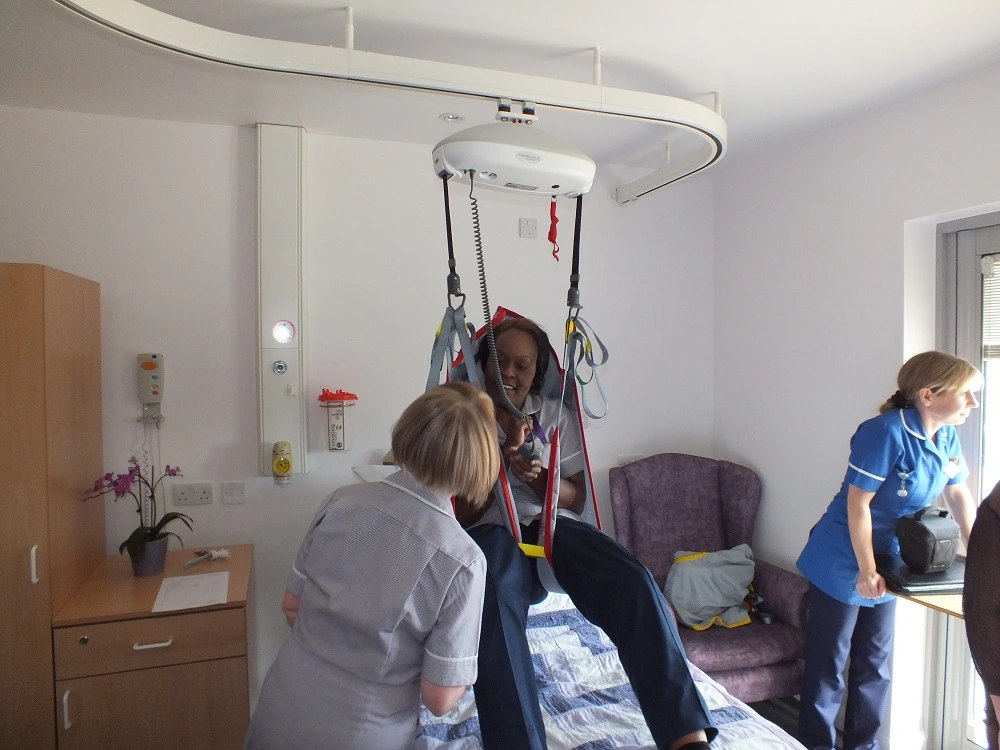Things to check before using a ceiling track hoist
Posted on 14 November 2018 By Aaron Stretton

In This Article
Whenever you’re using a ceiling track hoist, it’s important to do a few checks first to make sure that your…
Whenever you’re using a ceiling track hoist, it’s important to do a few checks first to make sure that your patient/client is as safe as can be.
Here is our guide on what to check before using a ceiling track hoist to make sure your system is in tip-top condition.
Jump Straight To –
- Have You Had Training?
- Is the Hoist in Good Working Order?
- Is the Hoist Unit Moving?
- How Does the Sling Look?
- Does the Person Mind Being Hoisted?
Have You Had Training?
Before you even get going with any part of the hoist system — have you been trained in how to use it?
Ceiling track hoists are vital pieces of patient lifting equipment, so getting trained up on how to use them is very important.
It’s important to remember that ceiling track hoists can include lots of different components that are all operated differently. You need to make sure you’re familiar with the whole system before you start lifting patients.
Make sure that you’ve had some training on the hoist system before you start using it with patients and clients.
We provide bespoke training sessions on all our hoist systems that we’ve installed, delivering them via video or in person.
Is the Hoist in Good Working Order?
Your ceiling track hoist system should be serviced once a year and LOLER tested every six months.
This will keep it in good condition and give you peace of mind that everything is in good working order.
You can check whether your hoist has been serviced in the last six months — there’s usually a sticker on the unit itself with a date. We can set up service contracts after all hoist installs to ensure your servicing and maintenance are taken care of!
Our engineers carry out LOLER tests every six months to ensure that the equipment we’ve supplied you with is still in top-notch condition.
Is the Hoist Unit Moving?
In order to find this out, you can check the movement of the hoist unit before you start using it. This is very straightforward; just use the hoist as you would if it was lifting a patient.
Use the handset to check the tapes go up and down, and you can pull the unit along the track to make sure that the trolleys are working fine and you won’t have any problems.
If you have a X-Y system installed, then you can also check that the traverse rail (the one that runs between the two parallel rails) can move around.
Other components like transit couplings and turntables can also be checked by taking the hoist unit through them.
How Does the Sling Look?
With most patients, you’ll be using a hoist sling to help lift and move them around. Just like the hoist unit and track, the sling should also be checked for any signs of damage or malfunction.
Here are list of things to look out for:
- Take a good look at the sling; if you see any tears in the fabric then the sling should not be used. Any damage (no matter how small) can cause concern for the safety of the patient.
- Always check hoist slings before you using a ceiling track hoist. Any rips or tears in the fabric can compromise the patient’s safety during transfers.
- The sling serial number should be visible and not worn, and double check that the sling is the right style and size for the patient (this should be detailed in the person’s care plan).
- If it’s a loop fixing sling, also ensure that you use the right colour loops on the shoulder and leg straps — again this should be detailed in the care plan.
- Ensure that it is the right type of fixing on the sling for the hoist — clip slings should never be used on loop fixing spreader bars, and loop fixing slings should never be used on clip fixing spreader bars.
- You should also check if the sling is clean.
Does the Person Mind Being Hoisted?
And last but not least, have you checked before using a ceiling track hoist that the person you are hoisting has given their consent? Wherever possible, it’s important to make sure that the patient has agreed to let you hoist them.
Some patients might not be comfortable with you touching them or handling them, so always try and make sure that you have got their consent before starting any moving and handling procedures.
You might find that people with dementia get a bit more confused or distressed when being hoisted. Try to keep talking to them and make sure they are okay through the transfer.
Summary
So, there are your five things to think about before using a ceiling track hoist.
Try and get into the habit of carrying out these five checks before every transfer to make sure that you and the patient are as safe as calm as can be.
If you require further advice on how to install, use or service a ceiling track hoist, please get in touch.
Speak to The Experts
Need assistance with product enquiries, general inquiries, or product support? Our Phonelines are open 9am - 5pm Monday to Friday
0113 519 0319
Or, fill out the form for a call back.

